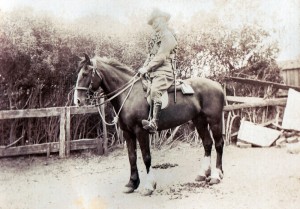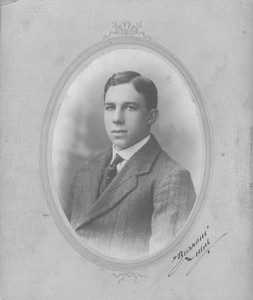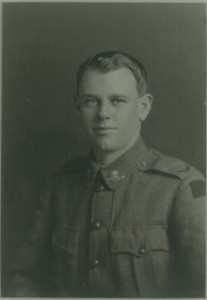Orvieto Family Biographies
Denny Hoskins
 Denise Hollingworth shares her personal recollections of her grandfather Denny Hoskins.
Denise Hollingworth shares her personal recollections of her grandfather Denny Hoskins.
Denis (Denny) Hoskins was born in Port Melbourne in 1884 and was the third of eleven children to Denis & Emily Hoskins.
Denny enlisted for service in World War I on 21August 1914, less than three weeks after Britain declared war on Germany. Although 29 years of age at the time, his papers stated he was 27.
For a man raised in the country, where work was hard and scarce, the notion of enlisting, seeing the world, and getting paid for it was exciting.
Denny was posted as a Private in the 1st Light Horse Brigade Headquarters, the 10th Regimental. As with most soldiers in the Light Horse, he took his own horse. It was during the training at the Broadmeadows Camp that Denny met Hugh Evan Heffer and in turn, the woman who would later become his wife, Hugh’s younger sister Bella.
On 21 October 1914, Denny embarked on the HMAT Orvieto, believing he was heading to the Suez Canal in Egypt, however he was disembarked at Alexandria and sent into action in the Gallipoli campaign. Appointed Corporal, Denny served in Gallipoli for six months before being transferred to Mudros for rest. The Anzacs were evacuated from Gallipoli in December and Denny rejoined his unit at Heliopolis, Egypt, in December 1915.
For his service in WWI, Denny was awarded the 1914-15 Star, British War Medal, and the Victory Medal. Denny served 1,645 days of service, of which 1,526 were served overseas.
Like most of his generation, Denny rarely spoke of what he saw or endured during the First World War. He never complained about the horror or conditions. He spoke a little about the bridges that were destroyed and certainly about the horses that were sick, wounded or killed.
Four months after arriving back in Australia, Denny married Bella, and although they married four and half years after they first met, the actual time they had been in each other’s company was less than six months. Bella’s brother, and Denny’s fellow Light Horseman, Hughie, was best man.
With the outbreak of World War II, Denny saw two of his sons enlist, supposedly encouraged by the fact that their father had attempted to enlist once again.
Despite rarely talking about his time as a soldier, Denny would always dust off his old tattered uniform every year to march at the ANZAC Day Parade – it was a great passion of his.
Denny Hoskins died in 1970 at the age of 85.
Hugh Evan Heffer
 The life of Hugh Evan Heffer – in the words of his great nephew David Heffer.
The life of Hugh Evan Heffer – in the words of his great nephew David Heffer.
Hughie, born in 1889, was the seventh child of George and Jessie Heffer. He grew up in Benjeroop, a small district on the Loddon River. The Heffer family had always been horse people, so it was no surprise when Hughie joined the 19th Light Horse Regiment in 1911, one of the part-time militia units that were raised in various states.
In 1914, Hughie enlisted in the 1st Light Horse Brigade Headquarters, the same month war was declared. At 25 years of age and with the rank of Private, he embarked on the HMAT Orvieto on 21 October 1914. The 1st Light Horse Brigade was originally destined to go to England for training before deployment to the Western Front in France. However, it was decided that the 1st Brigade should divert to Egypt where training would be undertaken at Camp Merna. The 1st Brigade was required to defend the Suez Canal before being involved in a number of key battles in the Western Desert of Egypt and in the Sinai Desert.
On 2 September 1915, while stationed in Egypt, Hughie penned a letter to the Kerang New Times to inform the community back home that the 6th Brigade, which included a number of Kerang locals, had just marched out of Heliopolis. Hughie also mentioned his copies of the Kerang New Times were being avidly read by the Kerang boys before they left Egypt for France.
 Hughie was transferred to the 5th Army Service Corp as a Driver for the Light Horse Brigade Train in September 1915. Injured in an accident the following July, Hughie was assessed as unfit for further service and he was invalided back to Australia. In September 1916, two months after the accident in Egypt, The Kerang New Times reported that Hughie was back in Kerang and able to move about with the aid of a walking stick. Hughie was officially discharged on the 21st November 1916.
Hughie was transferred to the 5th Army Service Corp as a Driver for the Light Horse Brigade Train in September 1915. Injured in an accident the following July, Hughie was assessed as unfit for further service and he was invalided back to Australia. In September 1916, two months after the accident in Egypt, The Kerang New Times reported that Hughie was back in Kerang and able to move about with the aid of a walking stick. Hughie was officially discharged on the 21st November 1916.
By the time that Hughie was returned to Australia, his younger brother Alex had also enlisted in the Army. Prior to Alex’s departure to France in October 1916, Hughie and Alex were photographed together.
In some way this photograph speaks to us of the personal dilemma confronted by so many young Australians. Alex was a young man ready to serve his country despite the risks, bloodshed and family help needed back home. The family were thankful when Alex returned to the district at the end of the war.
Hughie married Sarah (Sadie) Ann Crellin after the war on the 28 April 1920. Sarah passed away and much later Hughie remarried. Hughie passed away at the age of 77 on17 December 1965.
Bryan Joseph Rush
 Bryan McKay Rush shares the story of his father Bryan Joseph Rush.
Bryan McKay Rush shares the story of his father Bryan Joseph Rush.
Bryan Joseph Rush was born in Port Fairy in 1893. He was an active junior cricketer, a good student and a Collingwood footballer, playing 17 League football games with the Magpies during the 1913-1914 season. Bryan was working in the Treasury Department of the Public Service when war broke out. He enlisted in the early weeks and sailed with the first contingent of Australians in 1914.
Bryan served for most of the war with Army Headquarters in London and returned home with the rank of Captain. He and his brother Bernie were welcomed home with a grand celebration to their home in Richmond. In 1920, Bryan moved to Sydney, completed the necessary study to be a chartered accountant and joined with a fellow returned soldier in setting up the firm James and Rush, Public Accountants, in Sydney.
In World War II, Bryan again served as District Finance Officer, Sydney Barracks, with the rank of Major. He married Lorna McKay in 1927 and in retirement they moved to Melbourne.
Like many of his generation, my father never talked of his war experiences. In retrospect, his eagerness to enlist seems difficult to understand. Was it merely in search of new adventures or was it inspired by deeply-held convictions? Whatever the cause, it is apparent that Bryan was fortunate to avoid Gallipoli, the later trench warfare of Flanders, and to emerge unscathed from a lengthy period of service.
Bryan Joseph Rush passed away in 1982.
George Robert Carson
 Ian Carson shares the story of his Grandfather, George Robert Carson.
Ian Carson shares the story of his Grandfather, George Robert Carson.
George Robert and James Edward were identical twin brothers who served Australia in World War I. Born in 1891, both men served in the Gallipoli campaign, landing at Anzac Cove on 25 April 1915. Both men were wounded at Gallipoli, and in the case of James Edward, his injuries lead to his death in 1927.
George Robert, despite his injuries, went on to serve in other campaigns and was once again wounded in battle whilst in Pozieres, France. These injuries included bowel and bladder perforations from flying shrapnel and to his dying days he carried shrapnel fragments in both thighs.
Lance-Corporal George Robert was discharged on 22 June 1917, aged 25 years. In keeping with the sterile nature of military records, the lad with “fair complexion, brown hair, blue eyes” and height of “five feet seven inches” was recorded as having three vaccination scars on his left arm, three scars on his right leg and two on his left, one on his abdomen and one on his buttock. Nothing is recorded of the unseen and un-talked of mental scars.
In a moving letter sent home from Captain Jas Botwell Harris, a fellow soldier of George Carson, we come to understand the reality facing those on the battlefield, and it speaks to the courage of my Grandfather.
“I was engaged in a bomb fight against overwhelming numbers of the enemy. For nine hours continuously we were hand to hand with the Hun, fighting with bayonets and hand grenades. Grenades were falling like a shower of rain, ten to every one of ours. Men were falling wounded only to be blown to pieces by the next bomb before they could move away. Piles of dead were lying in the bottom of the trenches as high as a man’s stomach and every moment was expected to be the last.
While this was going on, a young Lance-Corporal fell badly wounded with shrapnel through his bowels and bladder, and with nine bomb wounds in the legs, after he crawled over some yards of blood stained ground which was covered with masses of dead …, through a shower of grenades, to his officer and, with tears in his eyes, apologised for being badly wounded, saying, “Look, Sir, I am sorry I am no use to you now.” Was anything ever heard of this man’s gallant conduct? No. But his name is George Carson.” Poziere, July 1916
George Carson returned to Australia in March 1917. For his service he was awarded the British War Medal, the Victory Medal and the Star Medal. George Carson passed away on 24 September 1947.





